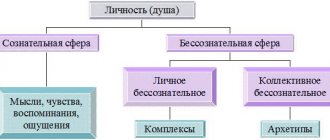Carl Gustav Jung is the founder of analytical psychology. It is interesting that while developing his theories and ideas, he often turned to world religions, occultism, Holy Scripture, and visited “places of power.” It was Carl Jung who introduced such concepts as the “collective unconscious,” “animus/anima,” and “shadow” into modern psychology.
Many argue that analytical psychology has revealed to the general masses the underworld of the human soul. Sigmund Freud first described the unconscious, which is home to complexes, fears, secret desires and sexual pathologies. And Jung spoke about the “shadow” - the stronghold of a person’s demonic energy.
First of all, Jung noted that the individual’s psyche consists of several parts. Its center is consciousness. One can imagine that this is a whole galaxy with “planets” - archetypes and the “sun” - consciousness at the center.
When we talk about a person, we mean a holistic personality, but in reality we are dealing with several subpersonalities.
In his studies, Carl Jung described these parts of the human “I” in detail. First of all, this is the Ego complex . Among the less significant ones, one can observe a father or mother complex, many constellations and archetypal images. If we take a closer look at a person, he consists of multidirectional attitudes that conflict with each other and create the basis for internal conflict. The most significant subpersonalities are Persona and Shadow .
Embracing an archetype
Excessive identification of consciousness with an archetypal image speaks of “being captured by the archetype.” Sometimes, it really looks like an obsession, when it seems that some foreign essence has taken possession of a person’s psyche and controls him. In fact, this seems to be true. While engulfed by an archetype, the individual loses conscious control, and power over his behavior is in the hands of the unconscious, instinctive.
At the same time, the archetypes themselves are objective, and the true causes of phenomena lie in the symbolism of archetypal plots. This mechanism explains why some dreams can be warning or prophetic in nature.
A mother in the form of a witch or a father with the head and hooves of a goat - such scenes in a dream can be interpreted as a warning about distortions in the sleeper’s perception of reality. The subconscious has more complete information about reality. And every now and then, it tries to reach consciousness in a dream, sending it signs designed to protect it from forming false beliefs in reality. Such dreams are often experienced by people whose relationships with their parents have taken an artificial form of goodwill, for example, as a result of being raised according to the model of overprotection - suffocating care. Such clients at an appointment with a psychologist are surprised why their beloved mother appears in their dreams in the form of an evil witch. However, this is a clear sign of repressing certain thoughts and feelings of a person regarding the mother, in this case, to the subconscious level.
Association of Depth Psychology Teurung™Shadow Phenomenon. Case study
“The unconscious is a wonderful universe made up of invisible energies, forces, forms of intelligence, even individuals that live within us.” ~ Robert Johnson
Article Shadow Phenomenon. Theoretical research
The shadow is an internal figure with a bright and dynamic diversity, conveying not just intense desires, but also the fullness of their diversity. We can say that each person, under the influence of the Shadow Archetype, simultaneously has many desires, which often contradict each other.
Therefore, one of the tasks and positive results of Dialogue with the Shadow is to calm the Shadow - by realizing the most pressing needs in the existing competition of desires that manifests itself on the threshold of consciousness.
“It is curious that people struggle with the positive aspects of their Shadow much more than with the dark ones,” writes Robert Johnson. “The feeling of inner nobility is much more shocking than the awareness of one’s worthlessness. Of course, a person has both, but he cannot reveal both of these qualities in himself at the same time.” [1]
And in fact, not only the so-called antisocial attractions become shadow, but also the positive traits of the human personality, since they are unclaimed or go beyond the established norm.
Having determined the state of shadow drives at a given period of a person’s life with one or another archetypal scenario, opportunities arise for their constructive implementation - finding a compromise between shadow desires, the needs of the authentic Self and the social reality in which the person finds himself.
Constructive interaction with the Shadow does not imply the destruction of existing social status, turning into an outcast and sociopath.
On the contrary, the archetypal resource of the Shadow allows one to increase social status, enhance significance, take authority to new levels, present to others original resources that a person did not have before - all these are possibilities for the constructive implementation of the Shadow.
This requires active and conscious participation of consciousness in this process. A dialogue with the Shadow is required. And for such a dialogue to be possible, it is necessary to know the interlocutor by sight, to see the appearance of the Shadow, to determine its desires that are relevant for a given period of life.
Projective diagnostic methods allow amplification to be carried out in accordance with mythological and poetic plots. And when we manage to see a familiar archetypal plot in the projective material provided by the client, here we become closer to the constructive implementation of his shadow drives, freeing up the creative resource of the Shadow.
As new methods for studying the Shadow, we use a type of art therapeutic diagnostic methods such as cinematherapy. The methodological basis of cinematherapy as a diagnosis is Jung’s method of transcendental function, which activates the process of spontaneous imagination.
In his works devoted to this phenomenon, Jung described in detail that spontaneous imagination is a process of imagining archetypes. Being initiated according to the method of the transcendental function, the process of spontaneous imagination becomes more conscious and visual.
Using certain stimuli that immerse the analysand in a state of transcendental function, we can assume that the process of imagining a particular archetype has been initiated. In this regard, cinematic stimuli are particularly effective due to their syncretism and emotional richness. Both the history of cinema and its modernity demonstrate to us that the theme of the Shadow is one of the leading ones.
The first film about Fantômas was made in 1913, Frankenstein in 1910, and the vampire film Dracula in 1921. Nowadays, the theme of the Shadow is experiencing a permanent renaissance in cinema. There are a number of works that are generally recognized as classics of “shadow” cinema. For example, one of these classic works is the film “Basic Instinct”, the main character of which personifies one of the most prominent shadow figures - the sociopathic one.
By amplifying materials from projective diagnostics of participants in therapeutic and developmental programs conducted by the Teurung Association of Depth Psychology, we can identify the most common archetypal scenarios and associated behavior patterns. Next, we will consider the main ones.
Archetype of Astarte
Archetypal figure of Astarte
– the personification of bright, frank, unbridled female dominance, realized through passionate, powerful erotic impulses. The image of Astarte served as the basis for the cults of the Greek goddess Artemis and the Roman Vesta.
Under the influence of such a shadow figure, indestructible confidence, ferocity, violence, and the desire for power are manifested. The sacred animals of Astarte were lions and leopards, and the bloody cult of the service of this goddess involved human sacrifices. The Phoenician goddess is the embodiment of female aggressiveness, the rage of a ferocious predator, but at the same time, aggression is not evil - rather, it is an excess of vital energy, a desire for influence in the male world.
Astarte in ancient times was the patroness of crazy love, which fell upon a man by a woman and drove him crazy, as a desire to exercise power over a man in order to obtain ecstatic, blinding pleasure.
The goddess, personifying female dominance over men, manifests itself in the woman’s psyche as the need for dominant power based on sex and aggression with violent, vivid emotions that are not subject to restrictions.
In this archetypal Shadow scenario, a man in the grip of love madness must fall victim to a fatal love in which the woman is the sexual predator.
Archetype Skadi
Archetype Skadi
- a deity from Old Norse beliefs. Skadi, the goddess of winter, was the daughter of a giant who came to avenge her father's death. The figure is very similar to the ancient Greek goddess Artemis, classified as an Amazon, but the characteristic feature of the archetypal Skadi scenario is a decisive, tough and uncompromising fight for the truth. She, like a lone wolf, is the personification of fearlessness and efficiency, composure and ferocity, and always follows her principles.
This archetypal figure gives a person both the desire and the opportunity to challenge both the social group and the entire society - to speak out against injustice. Such a shadow figure is characterized not by aggression, but by the search for truth; under its influence, it becomes very important for a person to form his own worldview, present honor and dignity, designate the categories of good and evil, sublime and base in practical meaning. The sharp, frank, straightforward nature of Skadi, a skier - the mistress of a mountainous northern country - is not a theorist of justice, but a practitioner.
She asserts justice wherever she is and sees violations, and without being restrained, she becomes merciless in her pursuit of perfectionism and the perfection of truth, leading to the fact that people next to her must be on the same level of morality, ethics, dignity and courage, otherwise she treats them like criminals. It especially hits men who show weakness.
Archetype of Artemis
Archetypal figure of Artemis
– goddess of the hunt and the Moon: an Amazon woman who can appear in various guises from a warrior to a seductress witch. Jean Shinoda Bolen, in his description of this archetype, emphasizes that Artemis personifies the independence of the female spirit.
As an archetype, it gives a woman the right to pursue her own goals in her own chosen field and the ability to focus completely on the subject that is important to her and not pay attention to the needs of others. A significant part of her soul does not belong to any man.[2]
Artemis (Diana to the Romans) is the goddess of the hunt and the Moon. The beloved daughter of Zeus and Leto, slender Artemis happily wanders through wild forests, meadows and hills, surrounded by nymphs and hunting dogs devoted to her. She is a sharp shooter, dressed in a short tunic, armed with a silver bow, and has a quiver of arrows over her shoulders. Artemis was also depicted as a moon goddess, holding torches and wearing a halo of stars and the moon around her head. [2]
We can assume the manifestation of an aspect of eroticism associated with provocativeness. Under the influence of the Artemis archetype, a woman challenges men, testing their strength and, at the same time, explores herself, starting a mutual experiment of testing feelings. As a result of such provocations and seductive spells that darken consciousness, Artemis helps herself to understand her own experiences.
Involving a man in competition, trying to weaken his will, insulting and provoking him in shadow manifestations, she performs a certain experiment - how strong the man will be, how generous he will be and how far he will allow her to go in his competition. But the result of such experiments is unpredictable, because the woman has no idea about the outcome, because she is inspired by the very process of competing with a man and, if he turns out to be a worthy opponent, for her this is the best reward, the best result of her efforts.
Athena Archetype
Among the archetypal scenarios of Amazon women, only with pronounced prudence and balance, Athena can be distinguished.
In ancient Greek mythology, Athena was the faithful daughter of her father Zeus, and in her unyielding will and clarity of mind she often even surpassed the supreme god Olympus. In myths we find many examples of how Zeus lost heart and even fell into fear, and his daughter, bright-eyed Athena, as the Greeks called her for her blue eyes, inspired her father with courage, as a result of which Zeus was inspired by Athena’s fearlessness and defeated his enemies .
As an internal figure, Athena is, first of all, the desire for unconditional success, but based on her own intellectual and volitional efforts. Among the ancient Greeks, Athena was the patroness of a predicted victory - conscious and reasonable.
Under the influence of the shadow figure of Athena, a woman has a desire to inspire and influence the man who is significant to her, just as the goddess herself influenced her father Zeus and other mortal heroes (Perseus, Jason, Achilles, Odysseus, Orestes), speaking on the side of patriarchy and inspiring them not feats they could not even imagine. Of all the qualities and mental processes, such a shadow figure as Athena primarily influences the will of a person, making it practically invulnerable.
Morgana Fairy Archetype
Often in the Shadow we see such an archetypal figure as Fairy Morgana
- a sorceress, a character in English legends of the Arthurian cycle (a natural phenomenon was named in her honor - Fata Morgana, a rare and complex natural optical illusion). Fairy Morgana became an integral part of the legends of King Arthur. However, Morgan was first mentioned in about 1150 in the work of Geoffrey of Monmouth “The Life of Merlin” (Vita Merlini). It should be noted that this was a rather short but meaningful mention: Morgana is the most powerful and beautiful sorceress of her nine sisters living on the magical island of Avalon. Arthur was entrusted to her care when he was wounded.
The Morgana archetype is reminiscent of Artemis, as a sorceress and witch-love spellcaster, she knows how to create illusions and, under the influence of this figure, a woman can draw a man into a world of bizarre fantasies. However, unlike Artemis, who is interested in the process itself, Fairy Morgana is interested in the goal - to charm a man, captivate him, tie him to herself.
And not just any man, but the best of them. In Celtic legends, Morgana enchants the most valiant knight - a man who acts as a model of honor and duty, as a result of his service becomes love for this woman. He sees her as his muse, for whose sake he performs feats and directs all the powers of his mind, courage and will in order to extol and please his beautiful inspiration.
The image of the witch embodies the intelligence and strength of a woman so strikingly different from conscious rational thinking and the degree of female ambition. Her mind and strength are much more connected with nature, concentrated on the inner life, which arises from an unconscious source and is not subject to the laws of logic and cause-and-effect relationships. The witch finds herself outside the community and brings into it new combinations of well-known ingredients. It challenges, frightens and inspires. Her mind, if in demand, becomes wisdom. [3]
Fairy Morgana is a shadow figure who encourages a woman to be placed on a pedestal, becoming the object of true passionate service from a worthy man.
Hetera archetype
We also often encounter the archetypal Hetera
at the bright pole. Under the influence of such a shadow figure, a woman is characterized by a desire for bright, creative, sensual pleasures - eroticism, primarily in its psychological aspect. Feelings are important for Hetaera, because she is the mistress of sensual pleasures, a woman improviser who creates in a passionate and tender fusion with a man.
In this archetypal scenario, a woman feels valuable, desired, sweet, enjoys herself, and she longs to merge in this rapture with a man, share it with him, enjoying both herself and her partner. In this passionate and sincere love merger, she strives to achieve an ecstatic state when her individuality changes and new facets of her feminine Soul open up. That is, this is not just love pleasure, it is sensual creativity, revealing something new, hitherto unknown in a woman.
Also often, in repressed shadow desires, the archetypal scenario
of Getera
, but already at the dark pole. In the Shadow, this figure manifests itself as the desires of a fatal seductress who arouses passion in a man, draws him into herself, makes him throw everything at her feet, and then breaks his heart and leaves him devastated, despairing, hopeless - in the midst of the ruined life that he sacrificed for her.
Without exaggeration, this figure is very dangerous, because it awakens sophisticated, sadistic cruelty in a woman. It is quite difficult to enter into constructive interaction with such a shadow figure, since most often the archetypal scenario is activated through the desire for revenge. Falling under the influence of the shadow figure of Hetera is dangerous because it essentially starts the process of internal devastation - destruction without any potential for creation. After all, revenge strives to ensure that the object of its interest ceases to exist altogether.
Therefore, when interacting with a Shadow of such content, it is necessary to analyze who wants revenge, what kind of mental pain and suffering pushes a woman to realize the potential of the dark Hetaera to ruin a man’s life.
Most often this is associated with a traumatic experience, and when we manage to determine the true cause, the use of the potential of such a personal Shadow takes on a reasonable character, for example, a form of retribution - constructive aggression aimed at self-defense or compensation for the damage caused, admonishing a person in illusion.
Therefore, the most important thing here is to work with the true desires of revenge, which must be realized and changed. And what kind of impulse depends on the specific situation that caused the activation of the vengeful dark Getera.
Among the shadow figures associated with the Hetera archetype, one can distinguish the aristocratic courtesan.
Under the influence of this figure, a woman becomes not just sensual and sexy, she strives for refined, aristocratic pleasures, involving a man in sophistication. She is not just an erotic Muse, her influence is elevating, ennobling, awakening in a man high aspirations, nobility, and self-esteem. The hetaera-courtesan manages to combine passionate eroticism with sublimity and service. If a woman manages to interact constructively with this shadow figure, she is able to turn a man into a noble nobleman who, for the sake of the object of his adoration, will decide on outstanding extraordinary actions.
Electra Archetype
Also noteworthy are the figures of Electra
– this archetypal scenario relates to the psychotype of Amazon women. According to myth, Electra was a princess, her father's favorite - a warrior woman, determined, ambitious. At the light pole, she is a father’s daughter, who can do anything, but at the dark pole, she is attracted to power. A characteristic feature in such an archetypal scenario is a highly developed will, which allows you to use various kinds of manipulation to achieve your goals.
According to Nancy Carter, from a Jungian point of view, Electra represents a daddy's girl with a negative mother complex, puella aeterna
(an eternal girl) stuck in a liminal state between childhood and adulthood (like Persephone before her abduction) [4]. For Electra, paternal interests are the ideal that she strives to achieve and the realization of her life purpose. This is also a process of confronting the figure of the Great Terrible Mother in order to subsequently transform it in one’s inner space.
At the same time, this figure is very ambitious and ambitious; under its influence, a woman believes that she has a serious purpose and mission in life, in which she is not independent - she needs an ideal. In the myth of Electra, her ideal was her father - the greatest king of antiquity, Agamemnon, who captured Troy; in the same way, a woman, under the influence of the shadow figure of Electra, strives to find some ideal, goal or idea in order to fill her life with high content, to make it extraordinary, outstanding, striving for special achievements.
Hera Archetype
Often in the Shadow there is a manifestation of the archetype of the ancient Greek goddess Hera.
Majestic, regal, beautiful Hera, known to the Romans as Juno, was the goddess of marriage. She is the wife of Zeus the Thunderer (Jupiter among the Romans), the supreme god of Olympus, who ruled heaven and earth. Her name is believed to mean "Great Lady", the feminine form of the Greek word hero. Greek poets, when addressing her, called her “hair-eyed” - a compliment to her huge and beautiful eyes. Her symbols were the cow, the Milky Way, the lily and the peacock with its iridescent, bushy tail, whose eyes symbolized Hera's vigilance. The sacred cow has been an image that has long been associated with the Great Mother - the nurse who provides food for everyone [2].
Such a figure is the personification of the will to power, a model of restraint and dignity. This is an arrogant queen who conveys a sense of superiority, importance, and dominance. As a shadow figure, Hera awakens women to challenge those around them, primarily from a position of arrogance, aristocracy and perfectionism. The influence of the Hera archetype gives a woman a feeling of inner perfection, sophistication and impeccability, erecting an insurmountable boundary with everyone around her, less worthy in her opinion, obliged to serve her.
In such a state, it is difficult for a woman to be imperfect, demonstrating her superiority, she encourages people around her to strive for sophisticated elite perceptions and manifestations when they are next to her. She does not compete with other women because she believes that she has won the rivalry immediately and forever. At the dark pole, Hera personifies icy arrogance, contempt, which makes even the most arrogant and self-confident person feel like an absurd commoner.
The constructive realization of the potential of the shadow figure of Hera may consist in exposing base aspirations when a person hides his true intentions, sometimes without even realizing it. And in this case, the opponent’s vulnerability is exposed to elitism and aristocracy, ironic humor, bright superiority, transmitted by the Hera archetype, thanks to which the ability to awaken nobility, honor and dignity, especially in men, appears.
Pluto Archetype
In men, quite often we encounter the manifestation of the archetypal figure of Pluto,
and this is the Shadow of Zeus. Under the influence of the Pluto archetype, a man manifests the will to power, dominance, self-affirmation, the presentation of authority and the subordination of the entire surrounding space to his will. But if Zeus does this clearly and openly through intelligence, rules and organization, then Pluto realizes his power secretly through personal informal influence, manipulation, suggestion using various methods of suggestion. This is a mysterious figure that evokes fear and curiosity.
Pluto very effectively and quietly knows how to involve people in his interests, evokes in those around him a feeling of mysteriously enthusiastic adoration, next to him people feel like frightened, but at the same time, curious children to whom he can lift the veil of some secret and for this they are ready do a lot for him. Most often, under the influence of such a shadow figure, a person does not have to resort to any pressure or intimidation - after all, he is very good at sparking curiosity in people and in this way involving them in the realization of his goals.
Archetype of Attis
No less often, a shadow figure appears in a man’s inner world, correlated with the Attis archetype
- according to myth, a beautiful young man on whom the goddess Cybele brought down her passion. Attis is the Greek god of Phrygia (a region in Asia Minor), associated with the great Roman earth goddess Cybele, the giver of fertility. According to one ancient Greek myth, Attis, the son of a certain Phrygian, incapable of childbearing, establishes festivals in honor of the goddess Cybele - orgies, but he is killed by a boar sent by Zeus. According to another version, Attis is a beautiful young man whom Cybele herself fell in love with, and when he was about to marry the king’s daughter, Cybele, out of jealousy, sent madness upon him, and he died, and the repentant goddess asked Zeus to make her lover’s body forever young and incorruptible.
Marie Louise von Franz writes that Attis, the beloved son of the Great Mother, who embodies the eternal, ageless divine youth, represents the pattern of the pereg aeternus
, the eternally beautiful young god who is never sad, he is not familiar with human limitations, withering and death.
Many young people who have a pronounced mother complex, like this god, at some point realize that life itself does not allow them to remain forever young; youth must end. Their future is seen as brilliant, full of abundance, fame and wealth; but we know that nothing ever lasts forever - everything will come to an end due to the influence of the dark side of life. And therefore this young god always dies early, nailed to a tree, which again becomes his mother. The maternal principle, which previously gave birth to him, takes him back to itself in such a terrible way, and there he is overtaken by withering and death. [5]
Most often, the shadow influence of such an archetypal scenario in the male psyche is characterized by the desire to become a delightful, desired, adored victim of female passion, plunging into the full depth and unbridledness of her erotic aspirations.
Ares Archetype
Among the internal figures repressed in men, we also encounter the manifestation of the archetypal image of the ancient Greek god of war, Ares.
As a male shadow figure, he is close to the female figure of the Dark Hetaera, radiating a frantic thirst for revenge, destruction, and intoxication with blood. If the archetypal scenario of Ares awakens, a man wants war and aggression, because through such manifestations he feels the fullness of life. This fierce figure deprives a man of sensitivity to any rules, reasonable arguments, he begins to act under the influence of his mood, without being included in any beliefs.
At the same time, Ares is very sensitive to female influences; according to myth, the only woman who knew how to influence Ares and used it willingly was Aphrodite, the goddess of love. And the woman, under the influence of the Light Hetera archetype, has a bewitching influence on the man Ares; next to her, this ferocious predator turns into a passionate, loving lover. In addition, in its constructive manifestation, the figure of Ares in the Shadow contains great potential to fight for the truth, he is capable of becoming a noble robber, a knight without fear and reproach, who fights with opponents and he does not care how many there are and how strong they are, because he protects his ideals of justice and he does not care about obstacles.
————————–
As we see, from the drives repressed into the Shadow, which very often manifest themselves as a result of therapeutic work on the programs of the Teurung Association of Depth Psychology
, we note those that are associated with libido - the manifestation of sensual pleasures and aggression. And this is not surprising, because in Freud’s time the main taboo was physicality, but now repression has shifted to soulfulness and trusting experiences.
Shadow desires “knock” from the unconscious more often than others, especially those that are among the most forbidden. Although the sexual revolution occurred a long time ago, erotic shadow desires remain limited to this day. Sensuality, especially confidential, based on deeply personal, authentic experiences of erotic partners in our time, focused on physicality, is clearly taboo, and romance and sensitivity are perceived as a source of vulnerability.
Therefore, an important task is to identify which aspects of sensory trusting relationships are repressed into the Shadow, to determine the possibilities of accepting them and implementing them in relationships without the danger of their destruction. Expanding the range of sexual desires through interaction with the Shadow gives a new impetus to relationships and opens up in a person a new energy of pleasure and life activity in general.
So, based on the research,
we can draw the following conclusions:
The shadow is the most dynamic resource of individuation.
The dynamism of the Shadow's influence is associated with the confrontation of the Super-Ego. This means that those life scenarios of individuation that are initiated by the Shadow inevitably involve expansion into the immediate social environment and transformation of the social-role structure of the individual.
The predominant intentions of the Shadow are libido and aggression. Under the influence of modern cultural models associated with publicity, consumer society and hedonism, sentimental-romantic, confidentially close libidinal attractions become shadowy. And shadow aggression is primarily countercultural in nature. In essence, it is precisely this kind of shadow aggression that Herbert Marcuse describes in his philosophical concept of the “great refusal”, set out in the work “One-Dimensional Man. Study of the ideology of a developed industrial society”[6].
The most important task of the analyst when working with a client is to find the most constructive forms of such influence of the Shadow, which would not lead to the destruction of social status and ostracism of the individual, but, on the contrary, to the formation of a position of self-sufficiency, leadership, and social constructivism. To do this, we rely on the understanding of the authenticity of the ego, which is a development of Jung’s idea of anima media natura -
“the soul of the connecting nature.”
“In our therapeutic and research work, we use the transcendental function method as the main method for diagnosing the defense mechanisms of the unconscious. Based on the work of the same name by C. G. Jung, we proceed from the idea expressed by him that the process of active imagination is “the most effective way of bringing to the surface that content of the unconscious, which is located immediately beyond the threshold of consciousness and, being subjected to activation, as a rule, spontaneously breaks into the conscious mind." Both C. G. Jung and all his followers draw attention to the fact that the contents of consciousness and the unconscious very rarely fit together. Antinomic positions of the unconscious do not pose a particular threat to the ego until they acquire an excess energy charge. This, in turn, is observed when the rationalistic orientation of consciousness becomes overly concentrated, and, consequently, preventing any manifestation of irrationality. If the confrontation between the tendencies of consciousness and the unconscious becomes antagonistic, then there is a threat of a breakthrough of the antinomic tendency of the unconscious into consciousness.
However, it is the combination of the tendencies of consciousness and the unconscious that leads to the formation of a transcendental function, which, by the way, is called that because it allows the transition from the unconscious to consciousness without losing the content of the first. C. G. Jung calls this method constructive or synthetic, and the result of this synthesis is the insight of the analysand. Theoretically, the transcendental function is the very transitional space of the psyche, which C. G. Jung called “anima media natura”. However, even for an untraumatized person, using this function independently is a task of extreme difficulty. For a traumatized person, this is generally impossible, since the protective mechanisms of the unconscious disintegrate the transitional space of the psyche.
The analyst thus acts as an external integrating force for the “anima media natura” of the analysand, i.e. performs a transcendental function. In this regard, C. G. Jung notes the particular importance of transference for the process of analysis, since it is with the help of transference that the analysand “delegates” the transcendental function to the analyst. It is logical that this can lead to a very strong attachment of the analysand to the analyst, which, of course, also has its negative sides.” [7]
Article Shadow Phenomenon. Theoretical research
Irina Kalinina
analytical psychologist, Jungian psychotherapy, practicing consultant in the field of depth psychology, head of the Kyiv branch of the Teurung Association of Depth Psychology
- Robert Johnson.
How to master your shadow. Deep aspects of the dark side of the psyche. / Translation from English – M.: Institute of General Humanitarian Studies, 2014 – 96 p. - Jin Shinoda is sick.
Goddesses in every woman. The main archetypes in the lives of women / Jean Shinoda Bolen; [transl. from English G. Bakhtiyarova]. – M.: Svet, 2018. – 384 p. pp. 58-102. - Ann and Barry Ulanov.
Witch and Clown. Two archetypes of human sexuality. Part 1 – M.; “Castalia”, 2022. – 384 p. - Carter Nancy, The Electra Complex in the Psychology of Women:
trans. from English/Ed. and with afterword. L.A. Khegaya. – M.: LENAND, 2018 – 160 p. S. 09 - Franz M.-L.von F Phenomena of Shadow and Evil in Fairy Tales
/ Trans. from English V. Mershavki. – M.: Nezavisimaya, 2010. – 360 p. - One dimensional person.
M.: “Refl-book”, 1994. - 368 p. - Sagaidak A.N.
Anima media natura as a Jungian approach to the psyche / A.N. Sagaidak // History of Russian psychology in persons. Digest. – 2016. – No. 6. - With. 153-162
The Shadow Phenomenon. Theoretical research
Did you like it? Share the link on social networks:
Power over archetypes
Awareness of the system of one's own archetypes gives a person power over them. In the ability to recognize and decipher archetypes, a connection is made between two previously separated spheres of the human soul: consciousness and the unconscious. This connection in Jung's theory is reflected in the archetype of wholeness or “Self”.
Interpretation and analysis of your own archetypal dreams and ideas is the path to personal development and spiritual growth.
Understanding the language of the subconscious gives access to the true causes of phenomena and life situations encrypted in archetypes. Awareness is an opportunity for a person to gain free choice. Only through awareness of the influence of archetypes is it possible to manifest individuality, which is not mediated by unconscious irrational motives. From Jung's point of view, individuality is the antipode of archetypicality. By demonstrating his individuality in a conscious choice, a person moves away from given patterns of behavior. In this way he expresses his creative essence. Individuation is the path of soul evolution. This is the path from being captured by archetypes to achieving integrity, when consciousness and the unconscious merge into a single core of personality.
Mandala is a symbol of the archetype of the Self.
Jung's Basic Archetypes
In the personality structure, Jung identified 3 areas:
- consciousness;
- personal unconscious;
- collective unconscious.
Consciousness is the “I am aware” here and now. The personal unconscious is something that was previously conscious, but has moved to the level of the unconscious. But the collective unconscious is not acquired during life, but is inherited, like an information package of images and forms. At the same time, personality development according to Jung is based on the interaction of 5 main archetypes, with the help of which the connection between consciousness and the unconscious is carried out.
Jung's main archetypes:
- Ego;
- Anima and Animus;
- Shadow;
- A person;
- Self.
The dark aspect of Anima or the Shadow archetype in the form of Maleficent.
The essence of Jung's theory of personality
To understand what exactly is the essence of Jung's theory of personality, it is necessary to recall the basic principles of Freudian psychoanalysis. Freud argued that the behavior of any person is determined by those unconscious motives that are based on sexual desire. The cause of neuroses, depression and other internal conflicts are the inevitable contradictions between the conscious and unconscious parts of the same personality.
The conscious part of the personality or “super-ego” is in a permanent state of natural contradictions with unconscious impulsive desires conditioned by the animal essence of man, to which Freud gave the name “id.” Why do contradictions arise between the “superego” and the “id”? The whole point is that existing moral, ethical and social guidelines are aimed at suppressing the animal essence of man.
The ideas put forward by Carl Jung regarding the unconscious and libido did not completely coincide with the ideas of Sigmund Freud. Some of the Swiss’s views on the unconscious were based on rather exotic and not entirely acceptable principles for that time.
Although Carl Jung agrees with Freud's idea of libido, he argues that sexual function is not the main function of libido. According to Jung, libido as a source of natural contradiction is not only sexual energy, but some specific mental energy. Sexual energy is just a part of some psychic energy. Sexual need, like any other need, comes to the fore only when it becomes relevant and a priority for a particular individual.
If we consider libido from the point of view of Carl Jung, then the source of psychological problems can be not only unsatisfied sexual need, but also any other need that goes beyond unconscious animal impulses. Jung argued that animal or basic energy manifests itself not only in the field of unconscious animal needs, but also in those activities where a person acts on a conscious level.
Unlike Freud, Jung viewed the motives for personality development in a completely different context. The idea of the Oedipus complex created by Freud is explained by Jung as follows: the child feels a strong attachment to the mother, since it is the mother who satisfies the baby’s basic needs for warmth, safety, food, etc. Sexual energy as a motive becomes relevant during the period of puberty of a child, and not in the first years of his life. Although Jung does not deny that children can experience sexual desire even before the onset of puberty, the Swiss classifies such manifestations as fragmentary. Jung does not consider them separately, but through the prism of other mental needs.
Speaking about what exactly determines the impulses and motives of a person at the current moment in time, Freud argued that the childhood period of development and the experience gained in the past is the basis of human personality. According to Jung, personality development continues throughout life and does not stop in childhood or adolescence.
Jung argued that any person at any age can change in the most dramatic way, therefore his impulses and motives are determined not only by the emotional trauma received in childhood, but also by those current tasks and motives that exist now or will exist in the future.
Ego or "I"
The ego is the center of the psychic sphere. Here is the point of observation of the conscious “I” over the internal and external worlds. This is where the path of personality development or “individualization” begins, as Carl Gustav Jung defined it.
Individualization is the merging of consciousness and the unconscious in one single structure - the archetypal image of the Self .
Anima in the image of Eurydice, rescued from the underworld by Orpheus.
Introverts and extroverts
One of Jung's greatest contributions to modern psychology is the introduction of the concepts of extraversion and introversion. He introduced the concepts of extraversion and introversion as the main types of personality orientation (ego orientation).
Extroverts are people who direct libido (vital energy) outward, to external events and other people. They easily make contact with strangers, are communicative, friendly, often very talkative and active. By interacting with others, an extrovert develops as a person, so forced loneliness is difficult for him.
People of this type are usually influenced by their environment, adapt easily to the society in which they live, and are confident in a wide range of different situations.
Introverts are people who direct their libido to the inner world. Such people are prone to contemplation and introspection. They are less susceptible to external influences, less confident in relationships with other people and the outside world, and less socially adaptable than extroverts.
A person with dominant introversion is characterized by isolation, taciturnity, and a tendency toward loneliness. An introvert draws energy from his inner spiritual sources, therefore he avoids large noisy companies.
In each person, such polar types, as a rule, coexist together, however, one of them dominates. However, the dominant type of response depends to some extent on the situation. For example, a usually introverted person may be quite socially flexible in a situation that affects his interests.
Later, Jung complements his theory of psychotypes (psychological types). He believes that all personal differences manifest themselves in four main functions: thinking, feeling, sensation and intuition, with the help of which we can navigate both the external, objective world and the internal, subjective world. Thinking and feeling belong to rational mental functions, and sensation and intuition belong to irrational ones.
Each of us has each of these functions, in addition, each function can be oriented outward or inward and can be extroverted or introverted. In total, we get 8 different mental functions. One of them is the most convenient for adaptation, therefore it is considered the leading one and determines the personality type of the same name according to Jung: thinking, feeling, sensing or intuitive (extroverted or introverted).
Anima and Animus
Anima and Animus in Jung's analytical psychology denote the image of the opposite sex in genetic memory. Anima is the feminine in a man. Animus is the masculine in a woman. Jung calls this the image of the soul. It is in this image that people choose each other to build relationships and create a family. The image of the soul carries within itself the experience of all humanity, the experience of the race and the personal experience of a person in the sphere of relationships.
Anima and animus can take on a variety of archetypal forms, illuminating a positive or negative aspect of the personality.
For example, the feminine principle can be manifested in the role of a gentle maiden or an evil witch . The masculine principle can appear before consciousness in the form of a noble prince or a jealous tyrant.
The image of the soul influences not only the choice of a partner, but also relationships with the opposite sex in general. Who am I for my husband or wife - a “noble lady of the heart” or a “jealous vixen”; "knight" or "bluebeard"? Also, the manifestation of gender qualities in a person’s character, for the most part, depends on the individual archetype of Anima/Animus in the human psyche.
Anima archetype in the image of Venus - the goddess of beauty.
The Anima and Animus archetypes are dual, but their duality is in equilibrium.
The power of manifestation of one aspect gives strength for the manifestation of the opposite. For example, external demonstrations of strength indicate internal weakness. A strong woman who performs male tasks in life carries in her consciousness the image of a weak animus, according to which she subconsciously searches for an appropriate life partner. That's why women who are too strong choose men who are too weak. In general, we always choose those whose qualities reflect our inner nature.
Content
- Personality structure according to K. Jung
- Archetypes
- Introverts and extroverts
- Differences between Freud's psychoanalysis and Jung's analytical psychology
Carl Jung (1875-1961) continued the development of psychoanalytic theory. He collaborated with Sigmund Freud and played a leading role in the psychoanalytic movement. But later Jung did not follow Freudian traditions, but went his own way, creating an analytical direction. Therefore, the collaboration between Freud and Jung was not so long.
Shadow Archetype
The shadow is formed from attitudes and inclinations that were inherited to us, but which we ourselves do not accept. Everything that seems unflattering and unaesthetic; everything that we are accustomed to hiding from society behind masks of decency forms the Shadow archetype.
Jung concluded: what was rejected at the level of consciousness goes into the realm of the unconscious. And from there, through the Shadow archetype, it continues its impact on the psyche and behavior. The more actively repression works, the larger the Shadow becomes, and the more often and more strongly it interferes with conscious life.
The Shadow archetype in the image of Mephistopheles (left) from Goethe's novel Faust.
However, although the Shadow represents the dark aspect of the personality, its goals are quite constructive.
With its intervention in conscious life, the Shadow directs the personality towards the satisfaction of his repressed desires and the release of unexpressed emotions. Ultimately, the intervention of the Shadow should lead the individual to awareness and acceptance of his shadow side. Otherwise, what Jung called “the flooding of consciousness with archetypal unconscious content” occurs. In other words, psychosis.
The shadow reminds of itself both through the symbolism of the inner world (dreams) and in real figures of the outer world (people whom we do not like for unknown reasons). She can haunt a person's nightmares in the personification of a demon or monster. But it can also be projected onto others. So, sometimes we can encounter qualities in those around us that will provoke our Shadow into action. And then, driven by anger and resentment, the individual succumbs to the unconscious influence of the Shadow and begins to commit inappropriate actions, which are often expressed in aggressive behavior, slander, and ill will. At the same time, the negative emotions that we experience towards other people are the result of a meeting of the “I” with our own suppressed shadow side. It’s not for nothing that spiritual practitioners have a recipe: if something in this person annoys you, look within yourself.
Symbolically, a meeting with the Shadow is indicated by looking at one’s own reflection.
Self
The Self is the archetype that leads from the primary polarity to the union of the conscious and unconscious through their common center. It is the achievement of oneself, that is, the achievement of an understanding of who we really are, that is the main task on the path of life. According to Jung, the “I” is not only the central point of the psyche, the organ of adaptation and homeostasis of individual perfection, but also the organizing genius of the entire psyche, responsible for the process of existence at all stages of the life cycle. According to Jung, the “I” is characterized by a specific theological function (the desire for completeness and awareness) - individuation. According to Jung, individualization is the act of self-creation of an individual, and the dominance of conscious or unconscious manifestations determines the unfolding characteristics of the self-image. When the “I” is achieved, “... consciousness ceases to be a wounded, egoistic accumulation of personal desires, fears, hopes and ambitions.... On the contrary, it takes on the function of connecting with the world of objects and leads the individual to an absolute, coherent and inextricable unity with the world in in general."
Jung was able to show that the waymarks denoting the process of individuation correspond to certain archetypal symbols, the manifestations and types of which are diverse. And here the personal factor plays a decisive role: for “method is just the path and direction along which a person goes in order to make his actions a true expression of his nature.”
Persona (mask), the archetype that most obviously dominates a person's consciousness and at the same time is the most superficial and amenable to reasonable assessment, refers to the social image of a person. Jung took the name from the ancient theater, where actors called the mask applied to the face a persona. We see a mask when we look at ourselves in the mirror.
The personal complex represents the social role that a person plays in meeting the needs of society, hiding his true self. It is a function that arises to satisfy the need for conformity or to provide some other convenience, but is in no way identical with the person as such.
A persona is a collective image through which people mistakenly perceive their own and others’ personality. For example, an actor with long hair and unusual clothes seems unique (as a character), while he simply dresses up and looks like the other performers in the group. A mask is an artificial, non-identical status of an individual that regulates its position in society, being a “packaging” for the “I”.
According to M. Jacobi, for a person who is in harmony with both the environment and his life, a mask is only a thin protective covering that helps natural relationships with the outside world. At the same time, an undeveloped personality makes a person very sensitive, and he feels threatened even when interacting with close people. For men, the mask often turns into a knight's helmet to protect themselves and follow the hero archetype (see below). The helmet narrows the view of reality, distorts the perception of oneself and one’s partner, and makes it uncomfortable and inaccessible for contact with the soul.
Very often one can see a tragic situation of identification with a personality, when the ego mistakenly believes that this is one of the roles of the personality. Then there is a feeling that a threat to the personality is a threat to the integrity of the ego itself. As soon as a person finds the strength to look “behind” a person, but then slips back, he finds himself in a defensive state. Instead of embracing the vagaries of the spiritual growth process, the person takes on a perceived defensive role.
Personas, like shadows (see below), arise in childhood due to a discrepancy between the child's spontaneous behavior and the expectations that come from meaningful adults. At the same time, in childhood, the desire to preserve and confirm one or another characteristic of the mask stimulates creative abilities, including stagecoach, “reincarnation skills” and imagination. However, when the ego suppresses this creative process, unexpressed and unfulfilled intentions fall into the realm of the shadows.
Persona Archetype
A person is an intermediary between the “I” and the outside world, a set of masks behind which the Shadow is hidden. In fact, this archetype is the social aspect of personality. All the best is collected in it. On the other hand, this is only an image that a person chooses in order to be accepted by society. And for this task he hides his dark side, pushing it into the Shadow.
Social models of behavior are dictated by a person. Persona is the face of the individual.
But the one who is possessed by the Persona archetype turns into a very comfortable and faceless person, devoid of individuality and living a life that is not his own.









